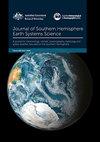ACCESS-CCM模拟南半球春夏季平流层准平稳波1的未来变化
IF 3.6
4区 地球科学
Q1 Earth and Planetary Sciences
引用次数: 0
摘要
南半球随季节变化的准平稳行星波活动影响平流层极涡赤道边缘内和附近的臭氧分布。准确地表示臭氧的这种纬向不对称对于表征平流层环流和气候及其在地面的相关影响是重要的。本研究利用澳大利亚社区和气候地球系统模拟器-化学气候模式研究了温室气体(GHGs)和臭氧消耗物质(ODSs)对50 ~ 70°S间总臭氧柱(TCO)和10 hPa纬向风纬向不对称性的影响。在1960年至2100年期间,使用固定的1960年水平的消耗臭氧层物质和温室气体进行敏感性模拟,并使用等效平流层有效氯和二氧化碳等效辐射强迫作为回归量的回归模式。该模式较好地模拟了春夏纬向波-1,尽管在相位和振幅上与观测值有轻微偏差。TCO和10hpa纬向波1的东移与臭氧减少和温室气体增加有关。振幅增加与臭氧减少有关,振幅减少与温室气体增加有关。消耗臭氧层物质的影响通常超过温室气体的影响,部分原因是温室气体对50°S TCO阶段的影响可能受到安第斯山脉的阻碍。因此,在21世纪,臭氧恢复的影响导致向西移动和幅度减小。春季70°S是一个例外,在那里温室气体的影响大于臭氧恢复的影响,导致整个21世纪持续东移趋势。温室气体对10 hPa纬向波1相位的影响最大,但对波1振幅的影响较小。由于纬向波-1相位的变化,不同地方经度的臭氧恢复速率也不同。本研究结果对了解温室气体和臭氧消耗物质浓度变化下南半球未来的臭氧层分布具有重要意义。未来重要的工作将包括进行类似的研究,使用大量的模型集合来获得更有统计学意义的结果。本文章由计算机程序翻译,如有差异,请以英文原文为准。
Future changes in stratospheric quasi-stationary wave-1 in the extratropical southern hemisphere spring and summer as simulated by ACCESS-CCM
Seasonally dependent quasi-stationary planetary wave activity in the southern hemisphere influences the distribution of ozone within and near the equatorward edge of the stratospheric polar vortex. Accurate representation of this zonal asymmetry in ozone is important in the characterisation of stratospheric circulation and climate and their associated effects at the surface. In this study, we used the Australian Community and Climate Earth System Simulator-Chemistry Climate Model to investigate the influence of greenhouse gases (GHGs) and ozone depleting substances (ODSs) on the zonal asymmetry of total column ozone (TCO) and 10 hPa zonal wind between 50 and 70°S. Sensitivity simulations were used from 1960 to 2100 with fixed ODSs and GHGs at 1960 levels and a regression model that uses equivalent effective stratospheric chlorine and carbon dioxide equivalent radiative forcing as the regressors. The model simulates the spring and summer zonal wave-1 reasonably well, albeit with a slight bias in the phase and amplitude compared to observations. An eastward shift in the TCO and 10 hPa zonal wave-1 is associated with both decreasing ozone and increasing GHGs. Amplitude increases are associated with ozone decline and amplitude decreases with GHG increases. The influence of ODSs typically outweigh those by GHGs, partly due to the GHG influence on TCO phase at 50°S likely being hampered by the Andes. Therefore, over the 21st century, influence from ozone recovery causes a westward shift and a decrease in amplitude. An exception is at 70°S during spring, where the GHG influence is larger than that of ozone recovery, causing a continued eastward trend throughout the 21st century. Also, GHGs have the largest influence on the 10 hPa zonal wave-1 phase, but still only induce a small change in the wave-1 amplitude. Different local longitudes also experience different rates of ozone recovery due to the changes in phase of the zonal wave-1. The results from this study have important implications for understanding future ozone layer distribution in the Southern Hemisphere under changing GHG and ODS concentrations. Important future work would involve conducting a similar study using a large ensemble of models to gain more statistically significant results.
求助全文
通过发布文献求助,成功后即可免费获取论文全文。
去求助
来源期刊

Journal of Southern Hemisphere Earth Systems Science
Earth and Planetary Sciences-Oceanography
CiteScore
8.10
自引率
8.30%
发文量
0
审稿时长
>12 weeks
期刊介绍:
The Journal of Southern Hemisphere Earth Systems Science (JSHESS) publishes broad areas of research with a distinct emphasis on the Southern Hemisphere. The scope of the Journal encompasses the study of the mean state, variability and change of the atmosphere, oceans, and land surface, including the cryosphere, from hemispheric to regional scales.
general circulation of the atmosphere and oceans,
climate change and variability ,
climate impacts,
climate modelling ,
past change in the climate system including palaeoclimate variability,
atmospheric dynamics,
synoptic meteorology,
mesoscale meteorology and severe weather,
tropical meteorology,
observation systems,
remote sensing of atmospheric, oceanic and land surface processes,
weather, climate and ocean prediction,
atmospheric and oceanic composition and chemistry,
physical oceanography,
air‐sea interactions,
coastal zone processes,
hydrology,
cryosphere‐atmosphere interactions,
land surface‐atmosphere interactions,
space weather, including impacts and mitigation on technology,
ionospheric, magnetospheric, auroral and space physics,
data assimilation applied to the above subject areas .
Authors are encouraged to contact the Editor for specific advice on whether the subject matter of a proposed submission is appropriate for the Journal of Southern Hemisphere Earth Systems Science.
 求助内容:
求助内容: 应助结果提醒方式:
应助结果提醒方式:


